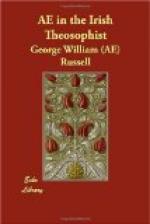The thinking principle in man, having experiences of nature through its vehicles, the subtle, astral and gross physical bodies, translates these sensations into its own set of correspondences: this principle in man, called the Manas, is associated with the element of akasa, whose property is sound; the Manas moves about in akasa, and so all ideas which enter into the mind awaken their correspondences and are immediately mirrored in sound. Let us take as an instance the perception of the colour red; this communicated to the mind would set up a vibration, causing a sound to be thrown outwards in mental manifestation, and in this way the impulse would arise to utter the letter R, the correspondence of this colour. This Manasic principle in man, the real Ego, is eternal in its nature; it exists before and after the body, something accruing to it from each incarnation; and so, because there is present in the body of man this long-traveled soul, bearing with it traces of its eternal past, these letters which are the elements of its speech have impressed on them a correspondence, not only with the forces natural to its transitory surroundings, but also with that vaster evolution of nature in which it has taken part. These correspondences next claim our attention.
The correspondences here suggested do not I think at all exhaust the possible significance of any of the letters. Every sound ought to have a septenary relation to the planes of consciousness, and the differentiations of life, force and matter on each. Complete mastery of these would enable the knower to guide the various currents of force, and to control the elemental knower to guide the various currents of force, and to control the elemental beings who live on the astral planes, for these respond, we are told, “when the exact scale of being to which they belong is vibrated, whether it be that of colour, form, sound or whatever else,” (Path, May, 1886) These higher interpretations I am unable to give; it requires the deeper being to know the deeper meaning. Those here appended may prove suggestive; I do not claim any finality or authority for them, but they may be interesting to students of the occult Upanishads where the mystic power of sound is continually dwelt upon.
The best method of arranging the letters is to begin with A and conclude with M or OO: between these lie all the other letters, and their successive order is determined by their spiritual or material quality. Following A we get letters with an ethereal or liquid sound, such as R, H, L or Y; they become gradually harsher as they pass from the A, following the order of nature in this. Half way we get letters like K, J, Tchay, S, or Ish; then they become softer, and the labials, like F, B and M, have something of the musical quality of the earlier sounds. If we arrange them in this manner, it will be found to approximate very closely to the actual order in which the sounds arise in the process of formation. We begin then with




